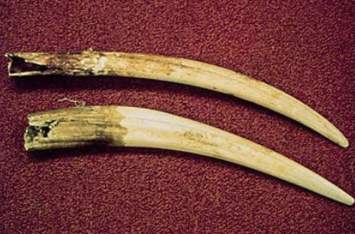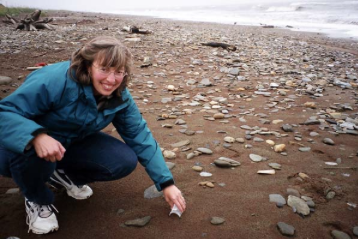Ivory Carving
The captain contemplated the walrus tusk. If he listened, it would show him what to carve. It had its own soul, and the captain brought out its beauty through careful craftsmanship. Until he started, he wouldn’t know what color or combination of colors it held. Some pieces had a milky iridescence while others looked creamy and smooth.
 As a boy he’d watched his father carve both intricate and simple pieces. He’d marveled as his father created scenes of Eskimo life, such as villagers holding a hide blanket ready to toss a young man into the air to spot whales or a hunter waiting outside a seal’s breathing hole. His father had taken pride in the small details, from the fur on each seal to the wrinkles of a walrus’ skin. While not quite as skilled as his father, the captain enjoyed the quiet meditation of carving. His own sons and nephews, however, weren’t interested. They had little patience for it. The few times they’d tried their pieces had gone up in dust as they whittled them down to almost nothing. They preferred the goods they could get at the local store in exchange for the raw ivory. Walrus ivory had always been highly valued. Traditionally, Native Alaskans used it to make boat keels, tools such as harpoons, jewelry and statuettes. It took on commercial value when Native Alaskans entered the cash economy, and became even more valuable in the early 1990s, when consumers turned to it as an alternative for elephant ivory.
As a boy he’d watched his father carve both intricate and simple pieces. He’d marveled as his father created scenes of Eskimo life, such as villagers holding a hide blanket ready to toss a young man into the air to spot whales or a hunter waiting outside a seal’s breathing hole. His father had taken pride in the small details, from the fur on each seal to the wrinkles of a walrus’ skin. While not quite as skilled as his father, the captain enjoyed the quiet meditation of carving. His own sons and nephews, however, weren’t interested. They had little patience for it. The few times they’d tried their pieces had gone up in dust as they whittled them down to almost nothing. They preferred the goods they could get at the local store in exchange for the raw ivory. Walrus ivory had always been highly valued. Traditionally, Native Alaskans used it to make boat keels, tools such as harpoons, jewelry and statuettes. It took on commercial value when Native Alaskans entered the cash economy, and became even more valuable in the early 1990s, when consumers turned to it as an alternative for elephant ivory.
People had long sought after elephant ivory for everything from piano keys to jewelry. Yet legal and illegal ivory trade nearly decimated the African elephant population. In just ten years, hunting for ivory nearly halved the African elephant population (and perhaps as many as 80 percent of East African elephants), with numbers plummeting from 1,300,000 animals in 1979 to 750,000 in 1989, and shrinking further to between 300,000 and 600,000 in 1995. In response, the Convention on International Trade in Endangered Species (CITES) banned commercial trade in elephant ivory in 1989. While illegal poaching continued, customers also turned to substitutes, like bone, plastic and animal teeth, as replacements.
Finding Walrus Ivory in AlaskaAs prices for carved walrus ivory rose, Alaskan Natives increasingly sold their handicrafts. Traders who came to the remote villages to buy them established close relationships with their master carvers and not only sold their work in the big cities, at nice profits, but launched the carvers as artists in their own rights.
The captain held the tusk in his hands. Its denseness made it heavier than it looked, about eight pounds. He mentally calculated how to divide the ivory, so as to waste as little as possible, and then made marks with a pencil. It looked good. He wrapped the tusk in a terry cloth towel and braced it in a small vice. Flipping on a bright spotlight, he plugged in his band saw and cut the tusk into two roughly equal parts. Ivory dust scattered across his work boots while the closet-sized room amplified the high pitch of the saw. He cut one of the sections again and set two of the chunks on the shelf above him. He then turned to the remaining piece.
He slowly rotated the ivory in his hands and pictured the walrus he would carve. He imagined where the head, tusks, body and flippers would go and calculated where to make the initial cuts. In carving, the artist worked backwards, creating a sculpture not by adding and forming pieces but by taking them away bit by bit. Since the band saw was good only for rough cuts, he swapped it for his Dremel grinder.
He switched on the radio, to drown out the steady whine, and started grating away the first layer where the figure’s head would be. He probably should have worn earplugs for the noise, but the mask and goggles protected him from the fine particles filling the tight confines of his workshop.
He kept working until a rough blob of a walrus finally rested on its ivory ice floe – his mental image of that first sighting when he was out hunting on a foggy day. Now came the fun part. With dentist-like tools, he scraped away around the head. Little by little, he made it rounder and more defined. He did the same for the flippers and body. He then carefully chiseled out a space between the neck and tusks. As the walrus took shape, he added more detail: skinfolds around the haunches and hindquarters, gentle shoulder muscles, and fine etched lines for fur. He even gouged out small spots for the eyes and glued in small bits of black whale baleen.
Finally, he was ready for the finishing work. With a hand tool he’d made from Maytag parts, he polished the whole palm-sized sculpture until every crevice gleamed. He put the piece aside and stood up, brushing the white dust from his clothes. He’d sell it to his trader next time he came around.
 Learn more…
Learn more…
How much does a walrus ivory carving sell for?
Prices vary depending on location and craftsmanship. In 2005, for example, a small (three-inch by one-inch) carving of a seal sold for $150 in Gambell but would have sold for $400 in Anchorage. Similarly in 2005, an Eskimo doll with an ivory face and fur ornaments sold for $200 in Gambell but would have commanded $750 in Anchorage and over $1,000 in New York.
